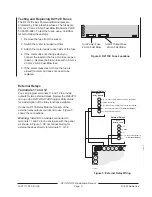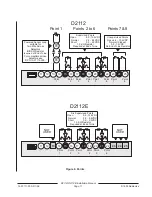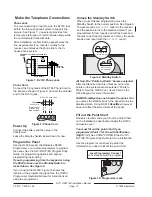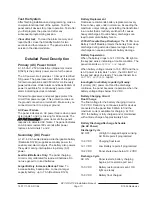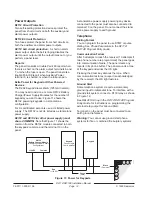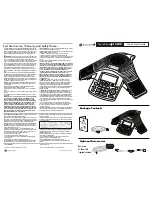
D2112/D2112E Installation Manual
Page 17
74-07111-000-D 1/96
© 1995 Radionics
Installation Guide for UL Applications
Introduction
The
System Chart references components evaluated
and listed by Underwriters’ Laboratories for
compatibility with the panel. These components
meet the basic system requirements for the
applicable standard.
The
System Wiring Diagram, Issue A shows the
relationship between the panel and the accessory
components referred to in the
System Chart. See the
installation and operation instructions for each
component for detailed instructions.
Optional Compatible Equipment
You can use UL listed components that do not
require evaluation for electrical compatibility in many
applications when installed according to the
manufacturer’s instructions.
Burglary Applications
You can use UL listed burglary alarm sensors that
do not require evaluation for electrical compatibility
in burglary applications. In some cases you must
use a UL listed Radionics interface module in
conjunction with the sensors. Consult the individual
component specification and installation documents
to determine suitability.
In burglary applications with one 7.0Ah, 12 VDC
battery the panel supports an auxiliary output of
350mA and an alarm (bell) output of 1.5A configured
as necessary. For additional loadings refer to the
Current Rating Chart for Standby Battery
Calculations.
For commercial burglary installations use a
maximum of 45 seconds of entry delay and a
maximum of 60 seconds of exit delay.
Test weekly: UL Standard 1023 requires a weekly
test. Configure the User System Test to test the
battery. See
User Configuration in the D2112/
D2112E Program Entry Guide for instructions.
Fire Applications
You can use UL listed fire initiating devices not
requiring electrical compatibility evaluation in any
application. For example: four-wire smoke detectors,
heat detectors, waterflow switches, and manual pull
stations are suitable fire initiating devices. Consult
the individual component specification and
installation documents to determine suitability.
When using four-wire smoke detectors, install a
suitable power supervision unit according to the
manufacturer’s instructions. Use the D133 Relay
Module to provide reset capability.
In fire applications with one 7.0Ah, 12 VDC battery
the panel supports an auxiliary output of 140mA and
a bell output of 720mA configured as necessary. For
additional loadings refer to the
Current Rating Chart
for Standby Battery Calculations.
D2112 only: Two-wire detectors must be electrically
compatible, and must be UL listed for use with the
D2112. See the Radionics Technogram
Smoke
Detectors Compatible with the D2112 (73-07115-
000), or you may contact the detector manufacturer.
Test weekly: Radionics recommends testing fire
and combined fire/burglary systems weekly.
Configure the User System Test to test the battery.
See
User Configuration in the D2112/D2112E
Program Entry Guide for instructions.
For all Burglary applications the panel must be
programmed to send a supervisory signal to the
central station a minimum of once every 24 hours.
Do not set or program an automatic telephone dialer
or similar device to place a call to a police station
number that is not specifically assigned by that
station for such service.
Sounding Device
The sounding device shall operate for at least four
minutes before an automatic cutoff for Household
Burglary applications and at least 15 minutes for
Commercial Burglary applications.
For all Commercial Burglary applications the system
must be programmed to sound the audible device
every time the system is armed.
Enclosures
The D2103 enclosure is suitable for Household Fire
and Burglary applications only.
Enclosure tamper protection causing an immediate
alarm signal is required for all burglary applications.
Radionics offers three optional enclosures.
The D8103 enclosure is suitable for residential fire
and/or burglary installations and commercial
applications that do not require attack resistance or
approval by Factory Mutual. (See the System
Chart
for acceptable applications.)







